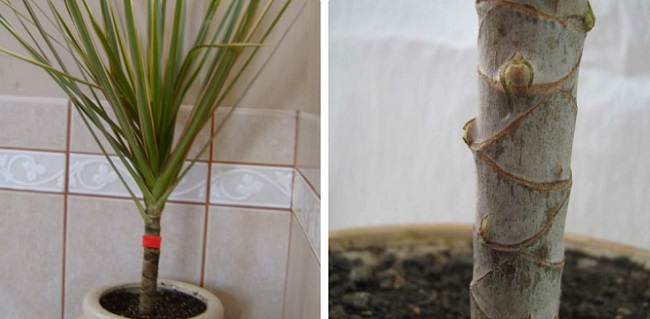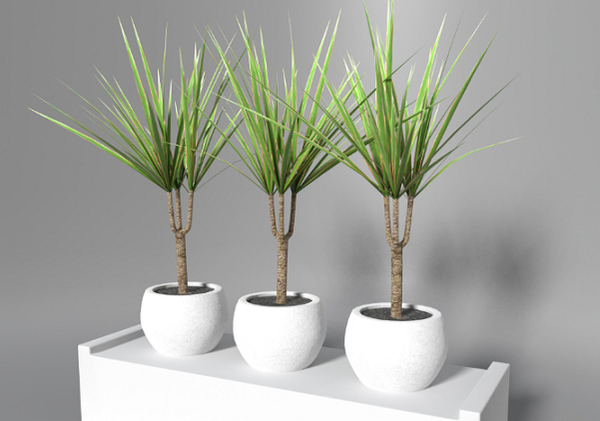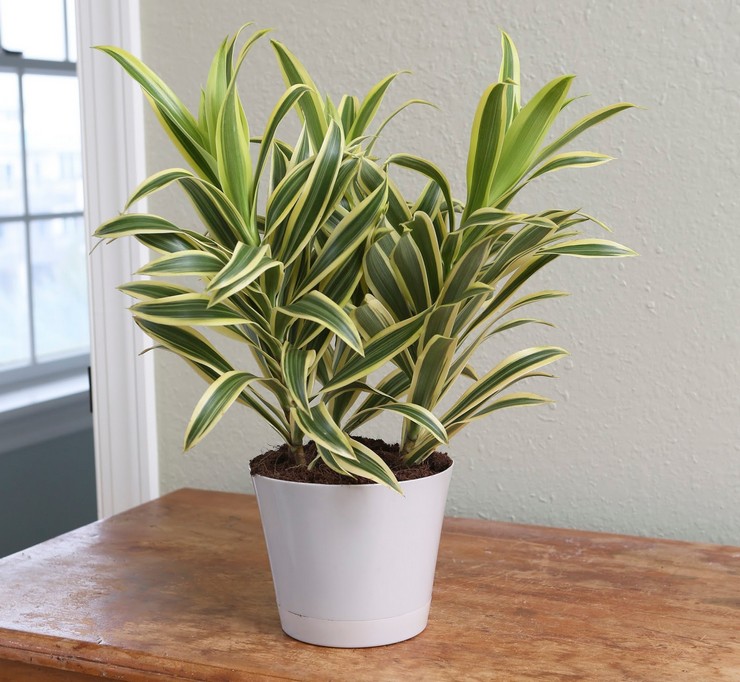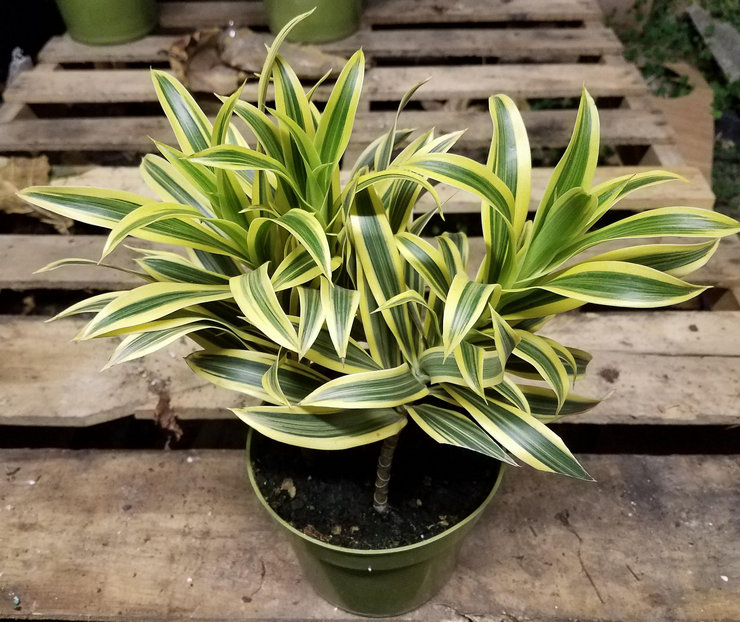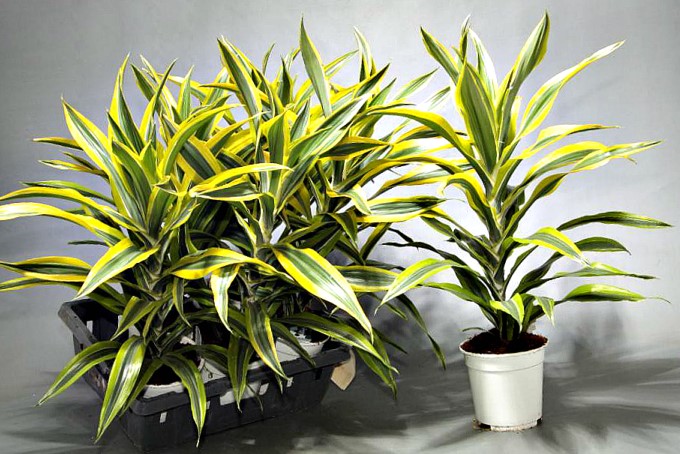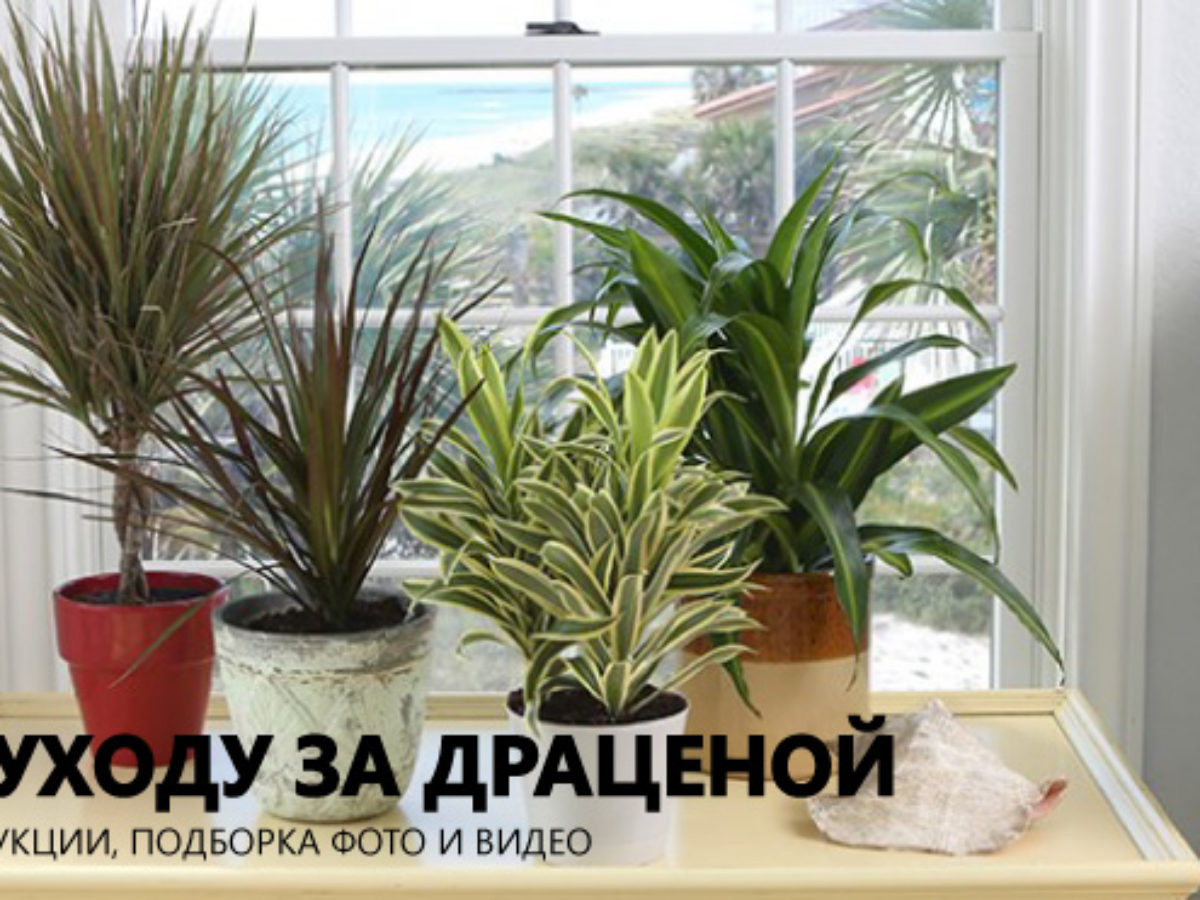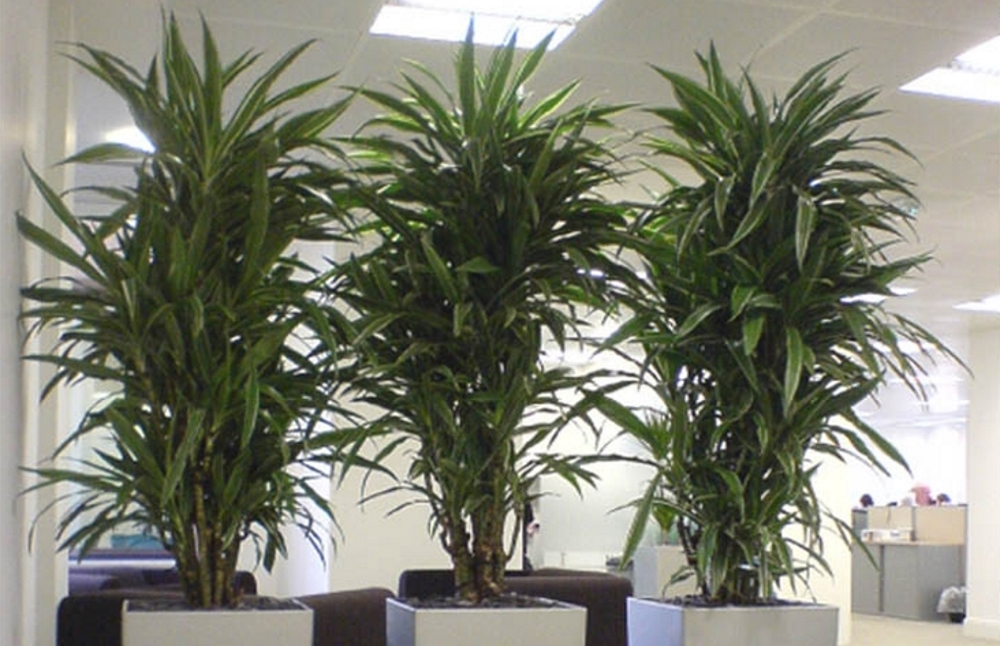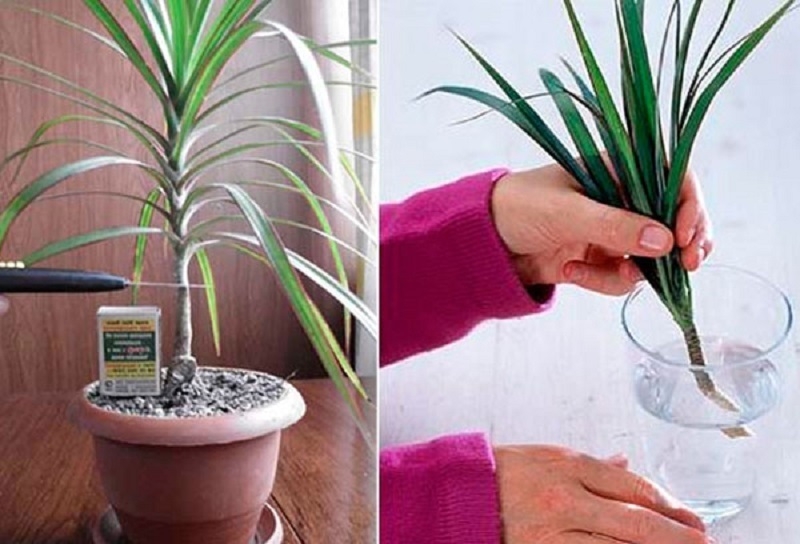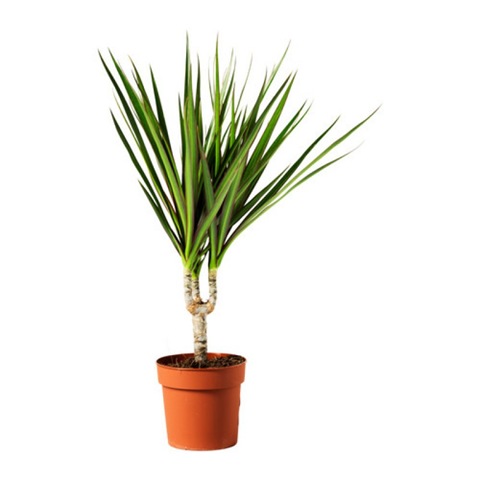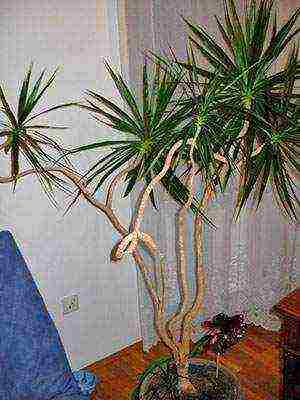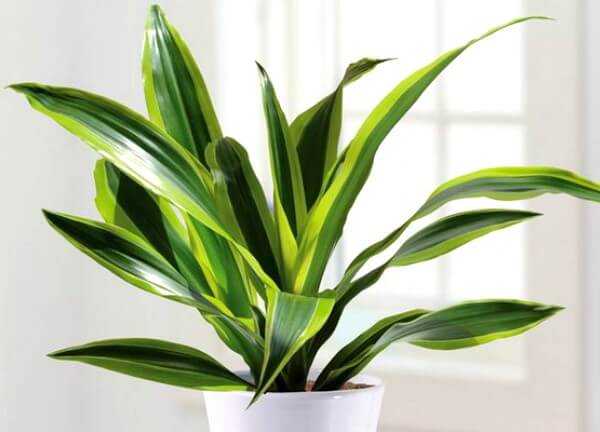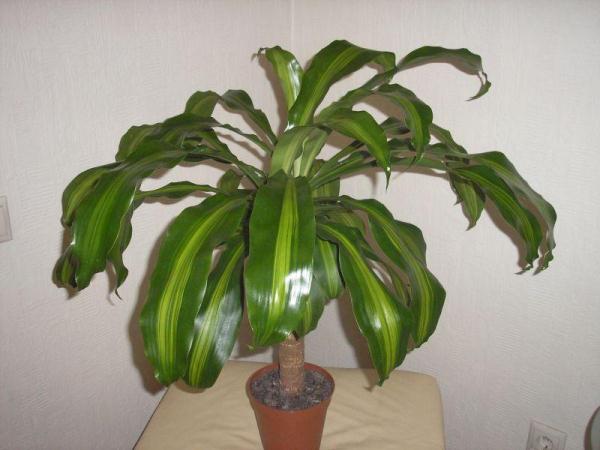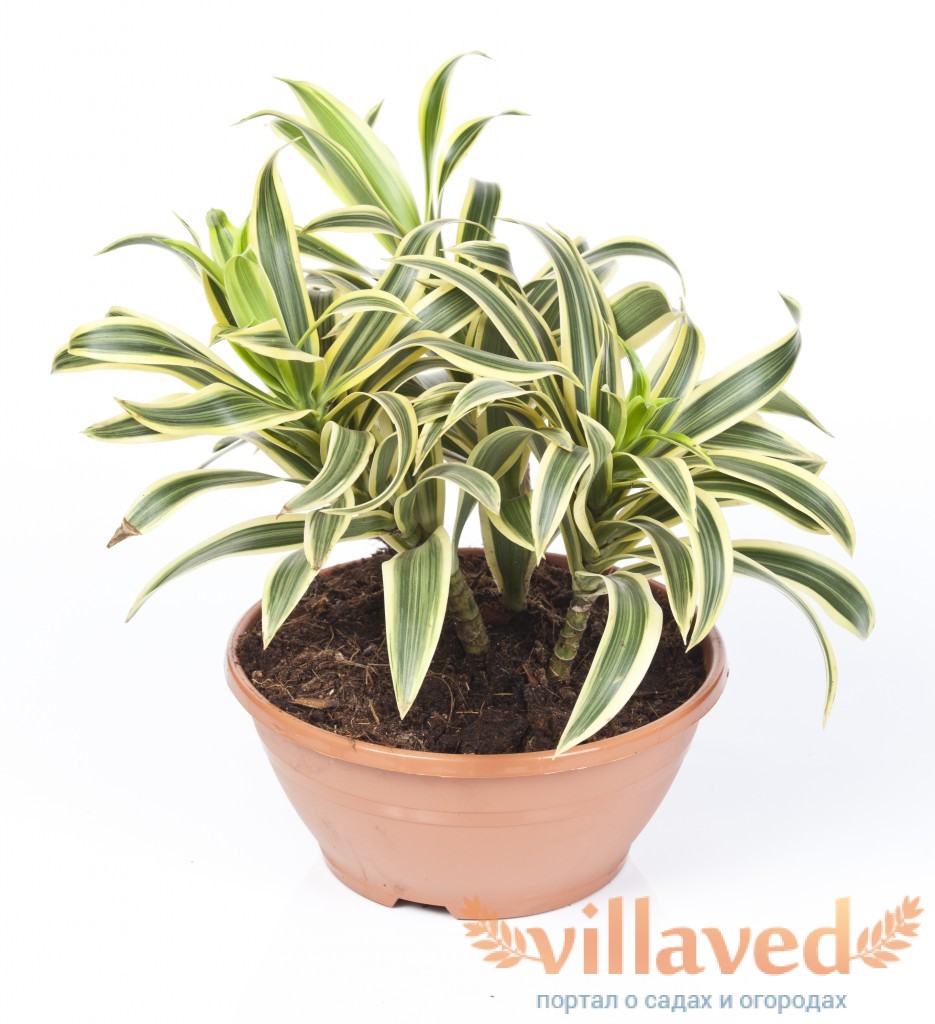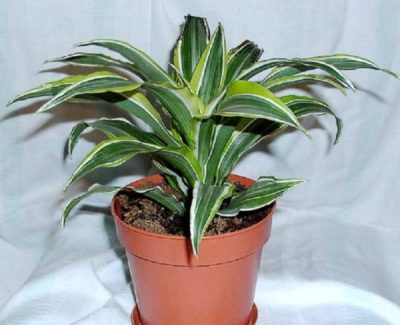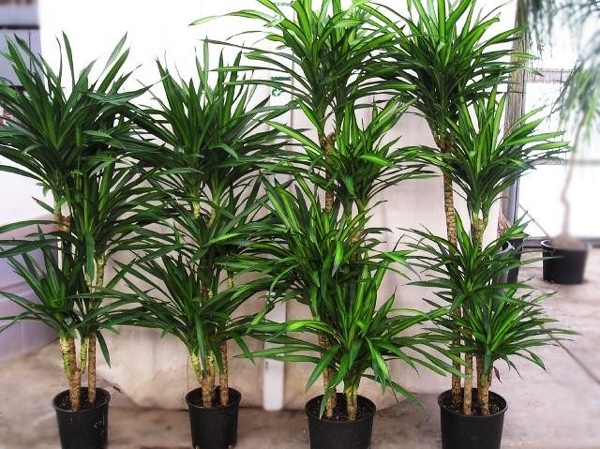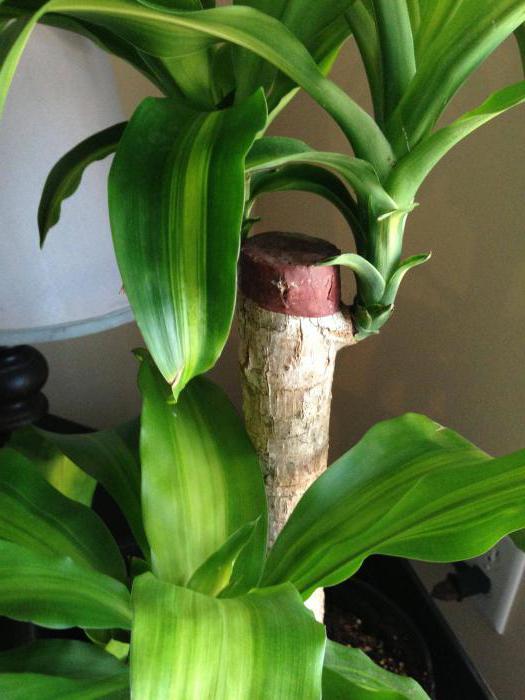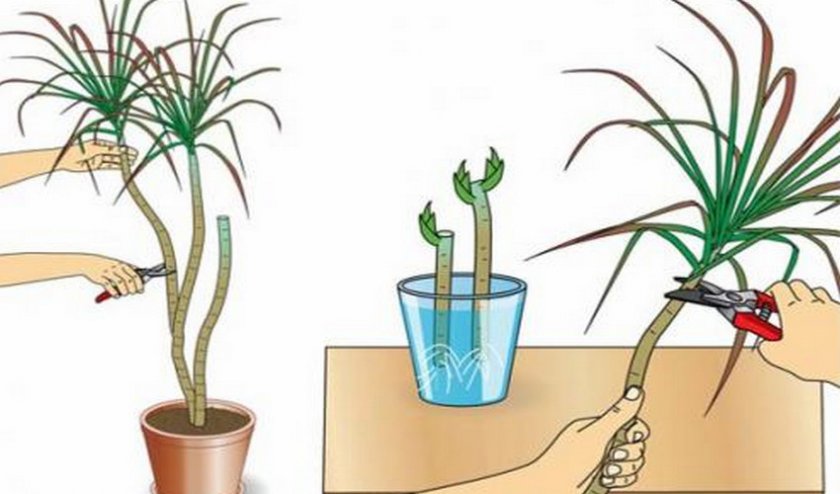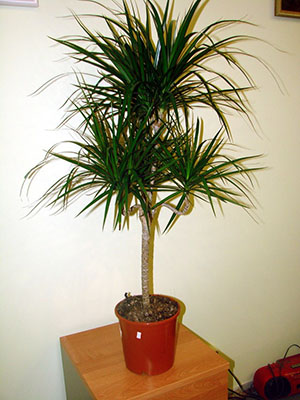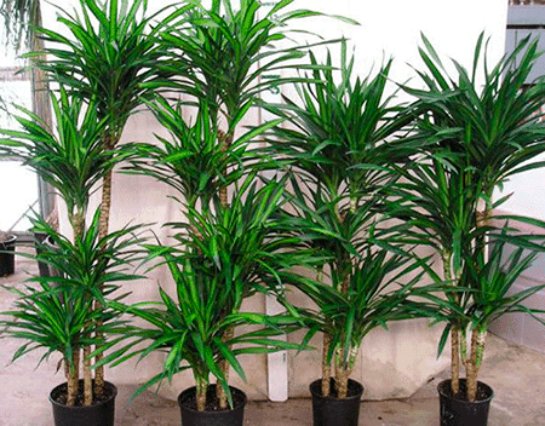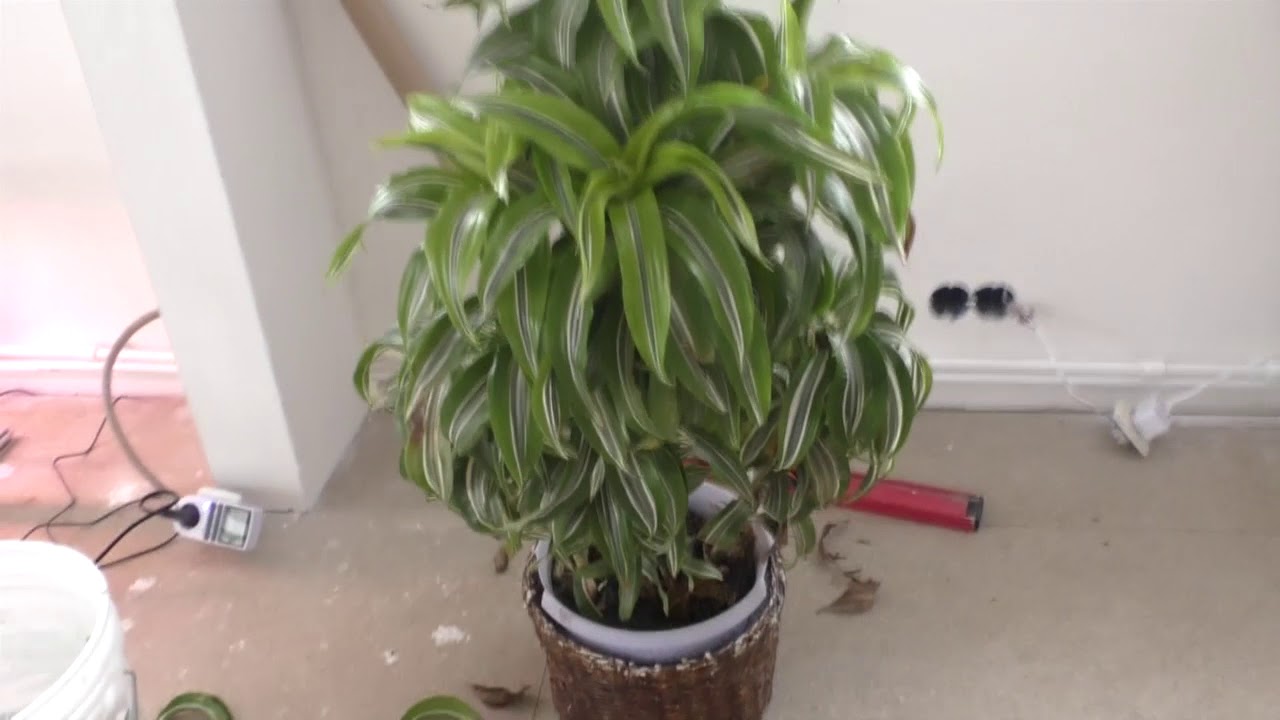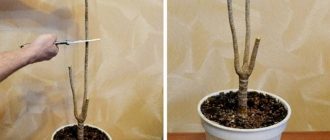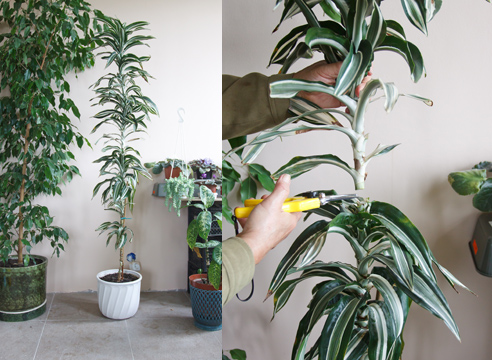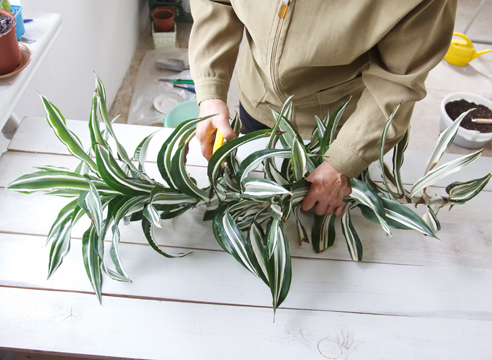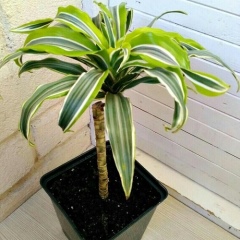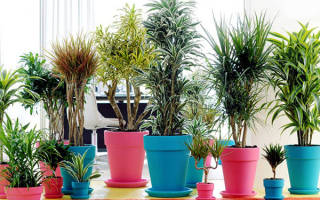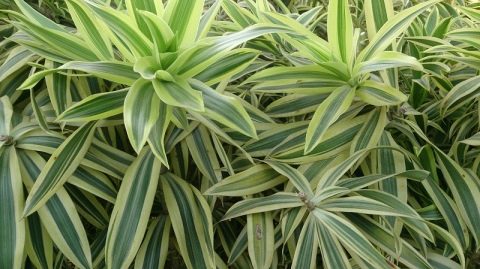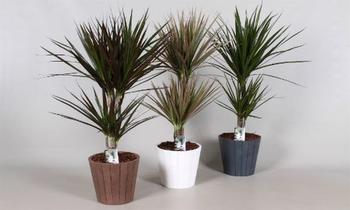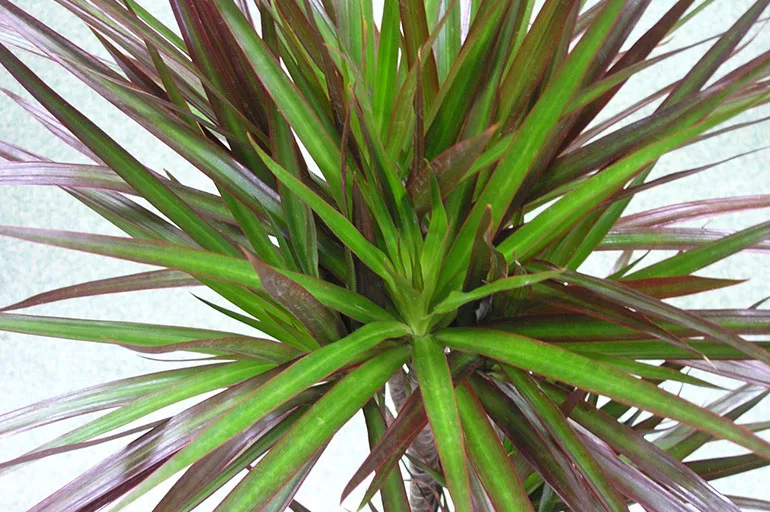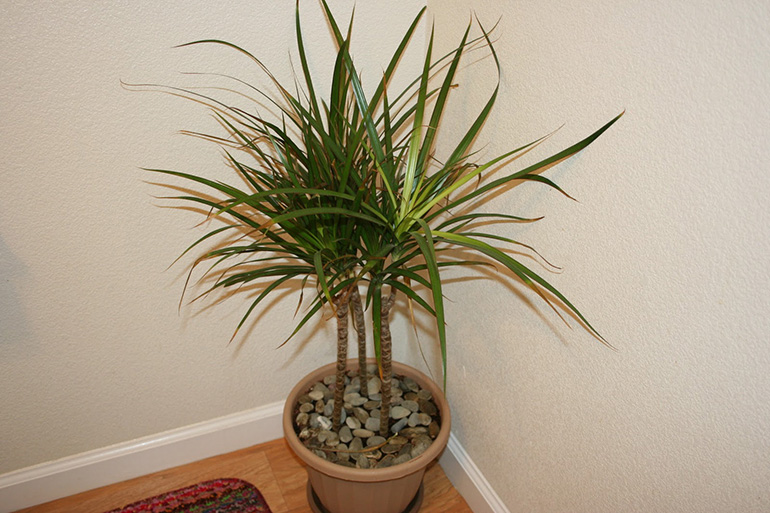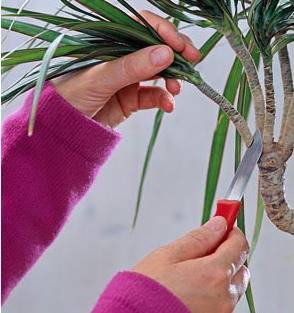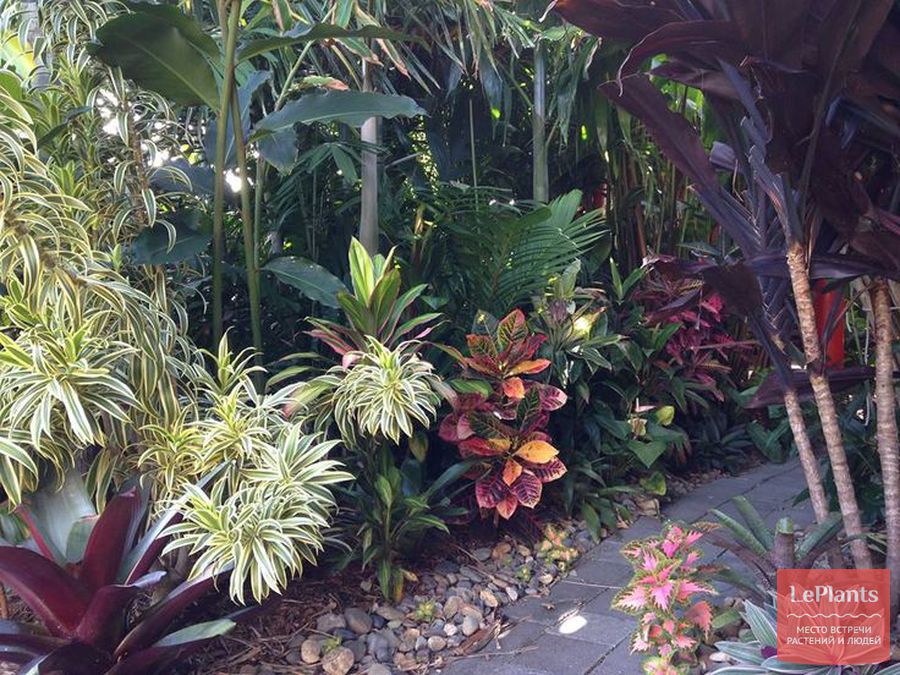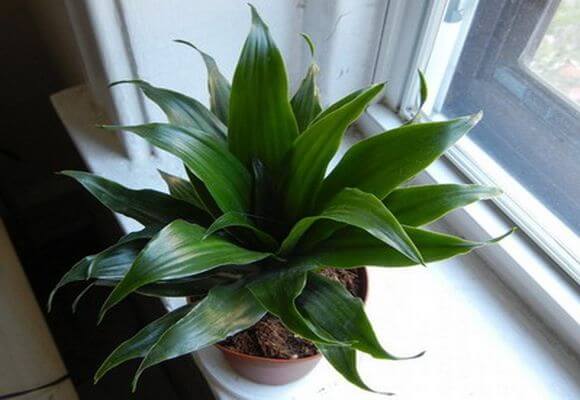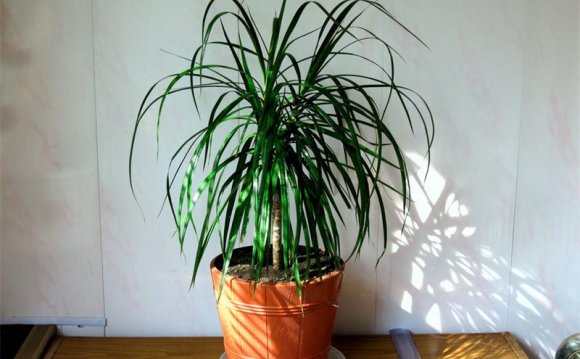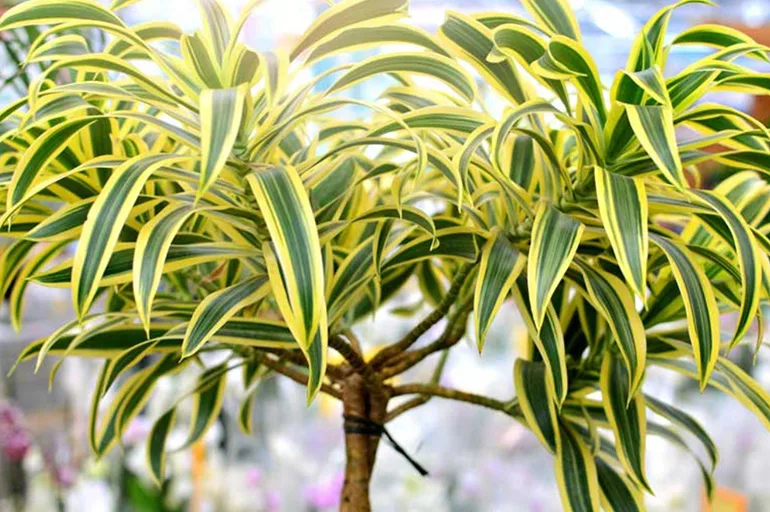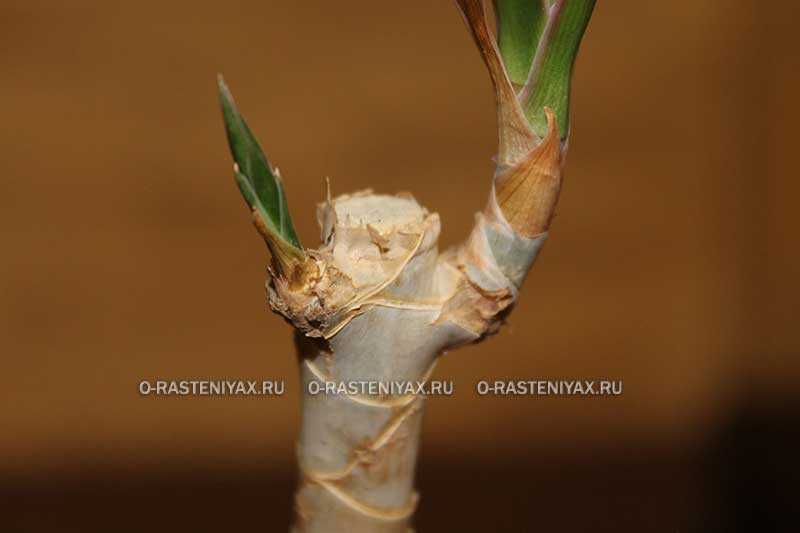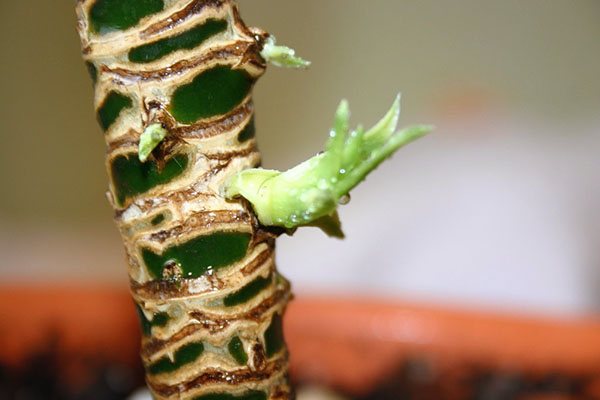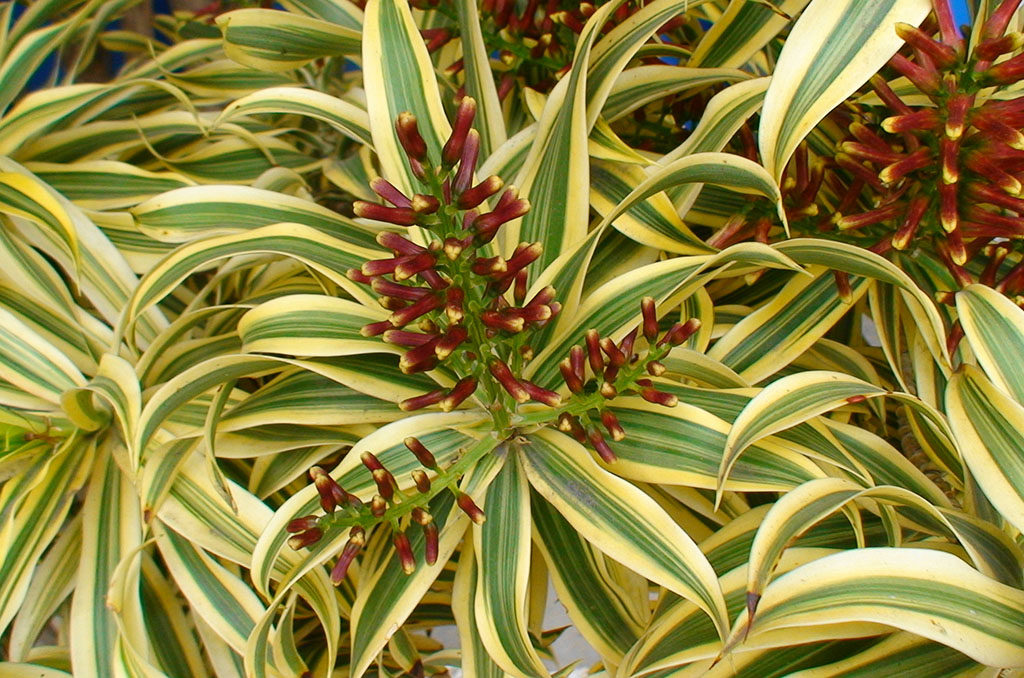Step-by-step recommendations
In order not to make the plant only worse or not to destroy it, you must clearly follow the step-by-step instructions during pruning.
To begin with, we take an alcoholized instrument for this. First, you need to determine the height where the cut will be made, while it is strictly forbidden that it be below the 30 cm area.The future cut should be located at such a level that there is easy access to light
Then, with a sharp disinfected knife, carefully and accurately make an incision in the place where the mark was made
It is impossible to break the shoots under any circumstances. The juice that appears at the place where the cut is made is removed with a cotton pad. Then this area must be treated with garden varnish, crushed activated carbon or molten paraffin. It is better not to use wax, so as not to harm the flower. This is to prevent the barrel from drying out.
To awaken the kidney formation on the trunk, it is recommended to treat it with a growth stimulant. An aqueous solution of biological growth stimulants is well suited.
Next, you need to wrap the trunk slightly below the cut with moistened peat moss and leave the cut open. Then put on a regular plastic bag or cling film to maintain the desired humidity and temperature. Then wrap the incision with peat moss.
The next month, new shoots will form on the trunk, but before they appear, you need to clean the greenhouse at least once every 5 days in order to water and ventilate the plant, and then we remove it in a dark, cool room.
In the event that you have a young dracaena with one trunk, with a good height, not less than 30 cm to the leaves, then you have the opportunity to prune it to obtain lateral shoots for branching. To do this, you need to cut about 10 cm from the top of the flower. After that, a certain number of shoots should form.
If pruning is done at home, certain rules must be followed. They will differ depending on the goal you have set: you will form a beautiful crown, you want to rejuvenate a flower or carry out sanitary procedures.
In order to cut a branch for a branch, a standard technique is used. At the first operation using a knife, the apex is cut off. Then it is necessary to treat the cut site with paraffin, after which the plant is placed in a dark and cool place. The temperature should not exceed +25 degrees. And for the plant to start branching, it will take a long time.
The flower will not sprout at once. This will take at least three months.
If you have already had experience with pruning dracaena, but many trunks have already grown, you will have to carry out this operation again. Cut the upper part of the crown at the same level. And we also remove damaged leaves, they will not make an attractive crown. In order to get a flower in several tiers, it is possible to trim the shoots at different heights.
Basically, such difficulties arise due to inappropriate care: too abundant watering, dry and cold air. Such errors are instantly displayed on the plant, it begins to lose color, the leaves dry up and fall off. In the process, the trunk is exposed, and the dracaena loses its beautiful appearance.
After the plant has been treated with antifungal agents, it is possible to cut it only after 10 days. This is done in order to stop the disease and remove damaged areas.
FAQ
However, it is not so easy to take and start the pruning procedure. There are many unresolved issues that need to be discussed in detail.
In order to avoid mistakes, be sure to study them in advance.
What happens if you pinch the top?
If you cut off the top in a favorable period, and most importantly, with a carefully and sharply sharpened tool in accordance with all the rules, then the plant will begin to grow from dormant buds.
Can the top be shortened?

In some cases, trimming the top is not only possible, but also necessary.
Cutting should take place according to the rules, and it is also desirable that after cutting the plant is properly processed.
Is it possible to shorten a part of the trunk and remove the leaves?
Indeed, it is possible to shorten part of the trunk, especially if it is overgrown, has an unattractive shape and bends under the weight of the crown.
But about the leaves, the question is quite different.
It is believed that leaves should not be cut off from dracaena. It is in the leaves of plants that substances will be formed that contribute to the construction of new tissues, and most importantly cells.
If you do not like the volume of the crown of the plant, it can be removed together with the cuttings, but it is not recommended to pull out the leaves separately, especially to cut them off in order to form the crown. You can simply kill the plant during its growth phase.
Dracaena is a unique palm tree that attracts not only with its appearance, but also with its properties. And yet, it is an unpretentious plant that is easy to reproduce. Subject to all the rules, as well as timely pruning, you can achieve the beauty of flowering and long life for your plant.
Previous
Pruning The subtleties of pruning hydrangea, including for paniculata and other species
Next
The secrets to pruning hibiscus at home and outdoors: how to shape a plant to bloom?
Dracaena species
Dracaena fragrant Dracaena fragrans is a perennial plant native to East and West Africa (growing at 7000 feet (2134 meters)), with a poorly branching, thick trunk. Leaves are sessile, widened at the base into the sheath covering the trunk, arcuately curved. Leaf shape is broadly lanceolate with a slightly wavy edge, about 60-70 cm long, 7-8 cm wide. Inflorescences are axillary, racemose, white or creamy green, fragrant. The original appearance is pure green leaves. But there are many varieties that differ in the shape of the bush and the color of the leaves. Grows at home up to 2-2.5 m in height. Fragrant dracaena with pure green leaves without a pattern is one of the most unpretentious types of dracaena, shade-tolerant and can withstand fairly cool temperatures up to 10 ° C in winter.
Dracaena deremskaya Dracaena deremensis is a plant with poorly branching, densely leafy thick trunk, gradually lignifying. Leaves are sessile, widened at the base into a sheath covering the trunk, up to 50 cm long, about 5 cm wide. The leaf shape is lanceolate, the edge is slightly wavy, tapering towards the ends. The original form with dark green leaves, but variegated varieties are more common. Flowers in axillary racemose inflorescences, red outside, white inside, have an unpleasant odor. This species is very similar to the fragrant dracaena, it is distinguished by narrower leaves and the color and smell of flowers. Although according to some sources, Dracaena deremskaya is not an independent species, but belongs to variations of Dracaena fragrant.
Dracaena Sandera Dracaena sanderiana is a compact plant native to West Africa, growing up to 70-100 cm in height, thin, densely leafy shoots. Leaves are lanceolate, about 20-25cm long, 3-4cm wide, light green. There are variegated varieties, for example, with a dark green border. Dracaena Sandera Dracaena sanderiana has a popular name "Lucky Bamboo" (Dracaena Lucky Bamboo) - as it is often sold in the form of rooted parts of the trunk (cuttings) collected in a bundle, similar to bamboo stems. They have nothing in common with bamboo, except for the name. Sometimes in plant growing factories, thin dracaena trunks are twisted and spirally curled cuttings are obtained, or several pieces are woven into a braid.This is possible only as long as the dracaena stems are young and bend easily.
Dracaena godseffiana -
has a look uncharacteristic for other dracaena, it is a shrub with erect thin stems, which are covered with thin membranous scales. The leaves are collected in false whorls of 3-5 pieces, oval or elliptical, pointed at the end, about 10 cm long and 5 cm wide. The surface of the leaf is green with white and creamy specks and dots. The flowers are yellowish-green, collected in few-flowered axillary inflorescences, fragrant.
Dracaena unbent Dracaena reflexa -
treelike dracaena, originally from Madagascar, in nature up to 4-5m in height. The trunk is inclined to branch, adult specimens are rather lush. Leaves are sessile, widened at the base into the sheath covering the trunk, lanceolate, pointed and bent back at the ends, about 15 cm long, 2.5 cm wide. Leaves are leathery, dense with fine venation. Inflorescences are loose panicles with small white flowers. Outwardly, at a young age, this species is very similar to Dracaena deremskaya, but differs in smaller leaves and a characteristic bent leaf edge. While in Dracaena deremskoy, the edges of the leaves are not bent, but simply can be bent from the weight of the longer and heavier leaves. The species has many varieties that differ in color of the leaves.
Dracaena marginata (bordered) Dracaena marginata is the correct name for Dracaena reflexa var. angustifolia i.e. this is also Dracaena unfolded, a narrow-leaved variation - a perennial plant, native to Madagascar, growing up to 3 m in height, with a thick woody stem, which usually has little branching and is very bare from below, while clearly visible traces of fallen leaves remain on the trunk. Leaves are narrow-linear, up to 50-80 cm long, about 1-2 cm wide, glossy, hard, sharp at the ends. The color of the leaves is predominantly green, with a thin red-brown stripe along the edge. May have yellow or red stripes depending on the variety.
This is one of the most common types of dracaena, it has several varieties, for example, Dracaena reflexa var. angustifolia 'Tricolor' (with narrow red and yellow stripes) or Dracaena reflexa var. angustifolia 'Bicolor' (with a wide red border).
Caring for fragrant dracaena at home
To grow a healthy and attractive plant, certain rules must be followed.
Location and lighting
Lighting for fragrant dracaena should be chosen bright, but avoid direct sunlight on the leaves. Variegated varieties prefer to receive a lot of light, while traditional dracaena varieties choose partial shade.
Temperature
The most favorable climate for growing dracaena shrubs is a temperature of 18 to 25 degrees. In summer drought, it is better to regularly ventilate the room where the pot is located. In winter, make sure that the temperature does not drop below 13 degrees.
Watering
The irrigation regime for fragrant dracaena should be moderate; the soil should not be heavily waterlogged. Otherwise, root decay may occur. The next watering is required only after the top layer of soil in the pot has dried. From time to time, the dracaena needs to loosen the soil.
Water for irrigation should be settled and contain a minimum amount of fluoride. Do not use cold water directly from the tap.
Air humidity
It is important to provide parameters of high humidity in order to prevent curling and drying of the leaves. For this purpose, it is necessary to spray dracaena daily, wipe the leaves from dust
Vases are placed on pallets, on the surface of which expanded clay and pebbles are laid. To ensure that the plant always has access to a source of moisture, water is regularly watered into the trays.
The soil
As a soil for growing fragrant dracaena, a ready-made mixture for dracaena or palms is used. You can make a suitable soil yourself: for this, 3 parts of garden land, 1 part of peat and 1 part of sand are connected. To ensure a good drainage effect, charcoal is added to the pot, as well as crushed brick chips.
Top dressing and fertilizers
In spring and autumn, every two weeks, the plant must be fed with complex fertilizers, and in winter this should be done only once a month. Try to avoid fertilizers that contain phosphorus.
Transfer
Young bushes of fragrant dracaena are transplanted in the spring every 2-3 years by the transshipment method
It is important to renew the soil in pots of adult specimens annually.
Pruning
Pruning is carried out if the dracaena shoots are very elongated and have lost their leaves. The top is shortened so that 4 leaves remain at the bottom of the trunk. The cut sites are wrapped in polyethylene for effective lateral bud formation. When the first shoots appear, the protective material can be removed.
Dracaena care after pruning
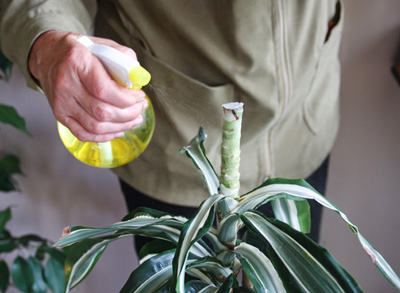 After trimming the dracaena, it is advisable to create comfortable conditions:
After trimming the dracaena, it is advisable to create comfortable conditions:
- A month after pruning, the dracaena should have new side shoots. During this period, remove the greenhouse from the flower and move the pot to a permanent place.
- Room humidity - 75%; air temperature - up to 25 °
- Lighting. Provide an even supply of diffused sunlight.
- Periodically turn the pot with the plant so that the shoots do not reach for the light and develop evenly.
- Make sure that the soil is constantly wet, but do not overflow.
- Spray the crown once a day with settled or filtered water.
- Water jet - fine spray that will evenly moisturize the entire leaf surface. Add "Epin" or "Zircon" once a week to stimulate the growth of new shoots.
IMPORTANT! Make sure that water during sprinkling does not fall into the rosettes of the leaves. This will protect the plant from trunk rot
Dracaena tolerates pruning well, allows you to form a fluffy crown. With the help of simple pruning, the aesthetic appearance is easily maintained and the beautiful shape of the plant is formed.
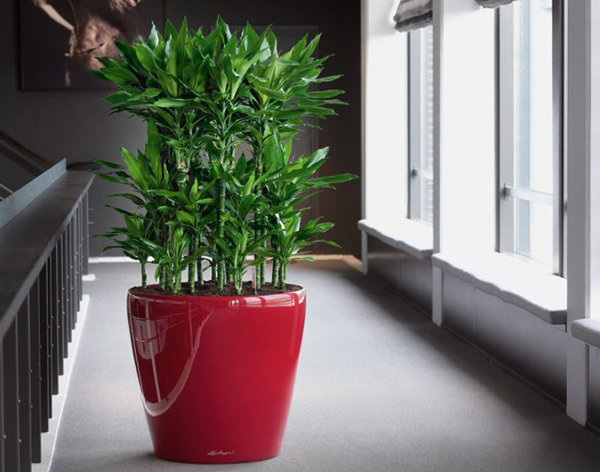
How to properly trim dracaena at home
At home, choose the type of pruning that most fully meets the purpose of the procedure:
- for branching;
- to save a sick plant;
- for reproduction;
- rejuvenation.
To get a multi-tiered plant, it is necessary to cut off the tops at different heights or cut off shoots of different lengths. The tools must be sharp so as not to pinch the cambium with vessels, otherwise the young seedlings will hurt and take root for a long time. Before pruning, you need to disinfect the knife with a fungicide, since spores tend to remain latent for a long time. Once in the nutrient medium, they wake up and begin to multiply in plant tissues.
Pruning dracaena for branching
If there is a single-barreled dracaena at home, how to prune for branching:
- the plant must be at least 30 cm in height;
- not have diseases or pests on the crown or trunk;
- more than a month passed after the purchase and the plant got used to new conditions;
- the season allows you to stimulate the growth of dormant buds near the cut site.
Even if the dracaena has several trunks, several more deciduous rosettes can be grown on each of them by cutting off the tops. It is better to do this at different heights in order to get a lush multi-tiered flower in a year or two.
The branching process consists in pruning all green tops, disinfecting the cut site. The flower should be temporarily placed in partial shade, as it experiences stress and may die due to direct sunlight, drafts or overflow. The earth ball should be slightly damp during this period.
New shoots form below the cut. Usually there are 3 - 5 of them. If they are located symmetrically, you can leave everything for further growth. If some have formed too close to each other, one that is weaker is removed with a knife. The cut is treated with a fungicide and covered with garden var, a small dosage of which can be bought at a garden store. Melted wax from a candle or paraffin wax will do.
To stimulate the formation of sprouts, you can purchase cytokinin paste - these are concentrated growth hormones, after which the kidneys will wake up faster and move into growth.
Crown formation
Pruning dracaena to form a crown is done in several ways:
- If the flower has one trunk, it is cut off, leaving 15 - 20 cm in the lower part. Soon, growing buds appear near the cut.
- If the dracaena is two- or three-barreled, then each trunk is cut at different heights so that the rosettes have more room for development. Pruning at one level will give a bunch of leaves that prevent each other from growing.
To decide in what places to make cuts, it is recommended to outline them with chalk on the trunk and imagine how the location of the sockets will look like in a few months - how symmetrically they will be located.
Sanitary pruning
If the disease of the flower was caused by improper care and the roots are affected by rot, then they cannot be used for further cultivation. The upper part is cut off closer to the ground and inspected. If the aerial part is not affected by fungus, does not rot, it can be rooted in the soil or put in Kornevin's solution to build roots.
After the summer, it is recommended to carry out a sanitary pruning of the leaves - remove the yellowed, but not yet dried parts. If the tips are dry due to lack of water, they should be trimmed with scissors without touching the green part, otherwise the drying process will continue.
For plant rejuvenation
Old dracaena usually looks unattractive: a bare long trunk, sometimes more than one, a small number of leaves at the top. To return the flower to its decorative effect, the stem is cut off with a sharp knife at a distance of 25 - 30 cm from the top, it can be rooted. Then the trunk is cut, leaving a stump 5 - 20 cm high.
Sections are poured with warm paraffin, before they need to be treated with growth stimulants. You can use sphagnum moss by wetting it and wrapping it 3-4 cm near the cut. Further, this place is covered with a plastic bag, which will maintain a humidity of about 80%. You do not need to cover the paraffin patch with a film - it should be in the air. Thus, the sprouts appear faster, and most of them survive. After awakening the kidneys, the package is gradually removed - daily opening slightly for airing for 15 minutes.
To get new plants
New plants can be obtained in two ways:
- cutting the bare stem into pieces and sprinkling it with soil;
- growing more buds at the cut site, followed by pruning and transplanting.
The second method is the most suitable, but you need to wait until the rosettes grow up enough so that they can be cut and rooted.
What does fragrant dracaena look like, which family does it belong to?
The leaves of the plant are long, strong, have a dense surface, join the top of the trunk in a circle. The color depends on the dracaena variety. Foliage can vary in color, from light yellow to dark green.

Blooming fragrant dracaena looks very decorative
There are cultures with double staining of the leaf plate. In such indoor flowers, streaks of white or dark green are clearly visible on the leaves. The trunk of an adult plant is bare.
Fragrant flowers are collected in numerous spherical inflorescences that are located along a long peduncle. Blooming brushes grow directly from a deciduous rosette.
Common varieties
Russian flower growers cultivate about 20 types of fragrant dracaena. All crops are suitable for indoor cultivation. Description of common varieties:
- Dracaena compact with good care grows up to 2 m. The perennial has a lush crown formed from long glossy leaves.
- Yellow Coast. The culture has a spreading fluffy crown. The leaves of the Ellow variety are colored green and yellow. Perennial grows up to 2m. in height.
- Dracaena Lemon Lime. The initially compact bush gradually turns into a tree. With proper care, the culture reaches 2 m. Dracaena Lime foliage is colored in all shades of dark green, yellow and milky. Dracaena Lemon exudes a subtle specific odor.
- Massangeana. Compared to other varieties of dracaena, this crop is more compact.The trunk grows up to 1.5 m. Florists love Massangeana for beautiful dense yellow-green leaves with thin stripes along the plate.
- Golden Coast. Indoor flower has a height of 1 to 1.5 m. Beautiful dense foliage creates a lush crown.
- Malayan. A spectacular tree with a voluminous green crown. The dracaena of this variety reaches a height of 2 meters. Attached to the top are wide, not long leaves. The color closer to the center of the rosette is almost white, the tips of the plates have a rich green color.

Dracaena Lemon Lime
First pruning of dracaena
The first pruning of dracaena is best planned for the period from May to June. It is then that the plant actively grows and develops. A layer will reappear near the top cut. New shoots will stimulate the plant to quickly heal wounds and begin to grow a crown.
Kidneys woke up on stumps
It also happens that the plant needs to be pruned in autumn or winter. This happens when the barrel breaks. With good plant care, this problem is solved quickly. The main thing is that everything is done following the recommendations of experienced florists.
Instruments
Before trimming the dracaena, you need to prepare the following items and tools:
- Sphagnum moss. It perfectly absorbs water and keeps it in itself for a long time. You can replace it with wet wipes, but they will have to be changed very often.
- Garden var. It is useful for treating a wound, from which juice will be released after cutting. Var promotes rapid healing. If this substance is not at hand, you can use a wax or paraffin candle.
- To keep the cut straight and neat, you need to take a sharp knife or garden pruner.
Pinching technology
You can choose the height for trimming based on the interior. It is necessary to take into account the fact that new sprouts will appear only if the plant is light enough. Lighting is the main requirement in the trimming process. Dracaena, which stands on the windows facing north or east, is pinched as low as possible so that the sun's rays fall on the cut site. Pruning dracaena at home should be as follows:
- The top of the flower should never be broken off. It is cut off with a sharp motion using a sharp knife. The cut off part can serve as material for the propagation of the plant by cutting. To do this, it is placed in a jar of water.
- The place where the cut occurred must be cleaned of the emerged juice and spread with garden varnish or other suitable substance. This is done carefully, trying to completely close all the pores. In this case, you need to ensure that the pitch is warm and does not burn the plant.
- Each leaf on the trunk must be trimmed.
- The trunk is thoroughly sprayed with water to restore the moisture that evaporated during the trimming process.
- The trunk is neatly wrapped with wet moss and fixed with thread or twine. When caring for a plant, do not forget to regularly moss the moss. It must not be allowed to dry completely.
Important! It is recommended to cover the treated stumps with films to keep moisture in the winding longer.
Dracaena should be watered in moderation
- Watering the dracaena must be done through the pallet.
- In the case of using a plastic bag, it is necessary to remove it from the stumps once a week and ventilate the plant. This way, the cut trunk will not fester.
- The plant must be moved to partial shade so that direct sunlight does not fall on it.
How to process a dracaena cut after pruning
Moisture evaporates quickly through the cut on the trunk, so it must be immediately processed and all pores closed. You can use wax or paraffin instead of garden varnish. For this, a wax candle is lit, and the melted substance drips onto the wound. In this case, care must be taken that paraffin or wax does not get on the leaves.
The trunk itself is recommended to be treated with a growth stimulant.This will help awaken dormant buds and encourage sprout growth.
Important! You can pinch only healthy plants that grow and develop well. In this case, the trunk must be at least 30 centimeters in height.
In this case, the trunk must be at least 30 centimeters in height.
What does dracaena look like after pruning
After trimming the dracaena, she looks completely unattractive. Over time, her crown will become beautiful and fluffy. For this to happen as quickly as possible, you need to create comfortable conditions for her. Care should be as follows:
- The polyethylene must be removed as soon as the first shoots appear on the trunk of the plant. The slice must also be open.
- The room temperature is maintained at least twenty degrees.
- The flower is transferred to a place where there is a lot of light, however, there is no direct sunlight.
- If pruning is done in winter, then daylight hours need to be increased to twelve hours. This is done using a fluorescent lamp.
- For irrigation, take only settled water or a solution with the addition of fertilizers. Dracaena is watered only if the soil in the pot dries out at least three to four centimeters.
- The new crown is regularly sprayed with lukewarm water to keep the humidity level. Spraying is done once every seven days using growth stimulants.
- A pot with a renewed dracaena must be turned towards the light each time so that the sprouts have the opportunity to develop evenly.
Pests, diseases and methods of dealing with them
On dracaena, you can find springtails, which appear when the soil is severely waterlogged. Spider mites, thrips, or scale insects can be brought home from the street or from the flower shop with new decorative flowers.
- Scale infestation is noticeable by the formation of brown plaques on the leaves and trunk.
- A spider mite is visible by a thin cobweb that entangles the leaves.
- Thrips leave light spots and streaks on greenery.
Seeing the signs of the disease, it is advisable to immediately treat the dracaena with an insecticide. For spider mites use "Fitoverm" or another acaricide.
If the substrate is wet, does not dry out for a long time and an unpleasant odor emanates from it, the dracaena needs to be urgently transplanted, its roots have begun to rot. The root system is cleaned of soil, washed under running water, treated with a fungicide, and then planted in fresh soil.
Dracaena will give the room an exotic look, will delight you with unpretentious care and luscious greenery. Experienced growers can even achieve flowering and take truly unique photos.
Dracaena varieties
In addition to proper pruning, it is necessary to take into account the varieties of the Dracaena palm. Since different types require special conditions for pruning. Here are the most popular varieties that are in homes or offices.
Fragrant dracaena belongs to especially large species. Its leaves are curved and hang down at the sides. The plant reaches a height of 5 meters. Therefore, it is recommended to purchase it in rooms with high ceilings. But doing your own pruning is quite difficult. To do this, you need to have at least some experience.
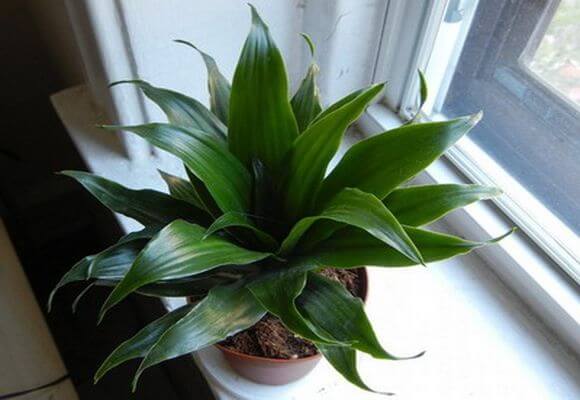
Dracaena Reflexa is a small bent bush that has several trunks and they grow straight from the roots. Leaves are usually elongated, curved and with yellow stripes. This plant does not need pruning.
Dracaena Surculosa grows to medium size and has dark green leaves with spots. Shoots of this species constantly appear, so it must be constantly cut off and this process must be constantly monitored. But the process itself is very simple and the gardener does not need special skills.
Dracaena deremskaya is a very large palm tree with a stiff trunk. The leaves of this plant are dark green - they are wide and long, which have yellow longitudinal stripes.
Dracaena Golden is a very unusual plant, but very difficult to care for. The leaves of this palm are wide and almost round with transverse white-green lines.

